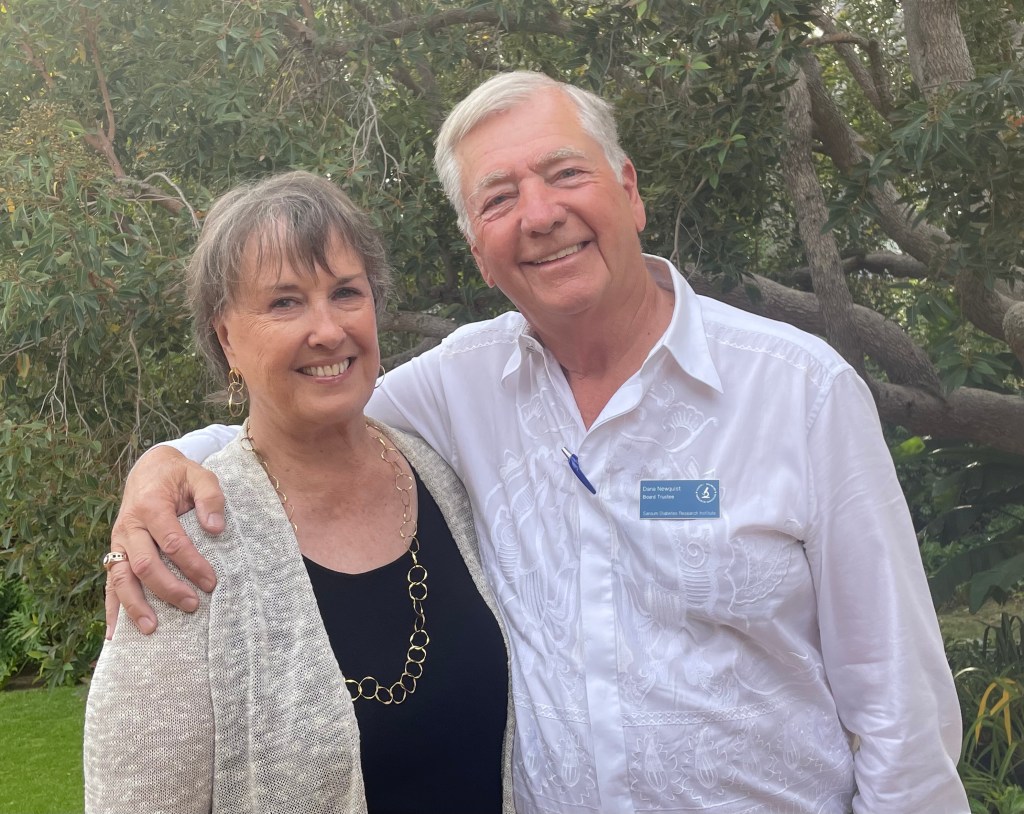Society Matters | Sansum Diabetes Research Institute Shares New Initiative with Donors
Precision Metabolism Looks at Effect of Diet on Complications from Diabetes

On June 9, Sansum Diabetes Research Institute (SDRI) held a soiree to share with donors its exciting new research program in Precision Metabolism and to introduce its new Chief Scientific Officer, Dr. Samuel Klein.
During the reception at the lovely Montecito home of Dana Newquist and Andrea Eltinge, donors mingled on the patio with SDRI staff and boardmembers before being seated inside for the informative program.
Executive Director Ellen Goodstein provided some historical perspective. SDRI is known throughout the world for the work of its founder, Dr. William Sansum, who was the first physician to manufacture and administer insulin to a type 2 diabetes patient in the United States. That patient, a farmer in Orange County, received the dose in 1922, and this year SDRI is celebrating the 100th anniversary, including at its Gratitude Gala in September. While SDRI and Sansum Clinic both bear this doctor’s name, the two institutions always have been completely separate entities.
Goodstein explained how among its many initiatives, for the past 13 years, SDRI has been doing groundbreaking work on the artificial pancreas, which is an external device that functions as an automated insulin delivery system. In collaboration with UCSB, SDRI has developed language that allows two devices, an insulin pump and a continuous glucose monitor, the latter of which measures insulin, to talk to each other and provide the right amount of insulin. SDRI’s work on the artificial pancreas continues, now in collaboration with three companies, to develop further iterations.
Goodstein introduced SDRI’s new Chief Scientific Officer, Dr. Sam Klein, a world-renowned metabolic disease expert. Klein explained how he was drawn to SDRI, which he termed a unique hidden jewel, because of its ability to move quickly, unlike big academic centers that require multiple levels of approval to move anything forward.
Sign up for Indy Today to receive fresh news from Independent.com, in your inbox, every morning.
SDRI was appealing also, Klein related, because it is geared toward clinical research, i.e., working on people. According to Klein, in the past 15-20 years, medical centers have shifted away from clinical research toward basic science, but eventually, one has to go back to humans and often, he shared, what is a cure in a rat has no application in a human.
Once SDRI reconfigures its research unit into a state-of-the-art facility, Klein related, SDRI can do sophisticated metabolic research to try to understand the multi-organ system abnormalities that are associated with type 1 and type 2 diabetes as well as complications from diabetes.
Klein explained how glucose control has been the focus for years, but that other factors affect how people with diabetes develop other conditions like kidney, liver, and heart disease. Under Klein’s direction, SDRI will examine the power of nutrition — how the different components of diet can affect cellular function. Klein noted the heterogeneity of people — what works in one person will not necessarily work in another. He shared his excitement for doing innovative, leading edge studies that go beyond glucose control to how to prevent diseases associated with diabetes. SDRI will partner with academic centers around the country, including UCSB and UCSD, to do the basic science work.
In a separate initiative, SDRI will be doing research on underserved populations. including looking at genetic factors that may explain why Latinos have a much higher risk of developing type 2 diabetes.
Klein related that philanthropic dollars are needed as seed money to launch its research projects. Research in humans is very expensive, he explained, and with philanthropic seed funding, small projects can generate data that can be submitted to the National Institutes of Health (NIH), where much more significant funding can be obtained.
According to the CDC, more than 37 million Americans have diabetes, which is more than 11 percent of the population. Of those, more than 8 million people are undiagnosed, and 90-95 percent of all cases are type 2 diabetes.
For coverage of other events, go to independent.com/society.
Support the Santa Barbara Independent through a long-term or a single contribution.








You must be logged in to post a comment.